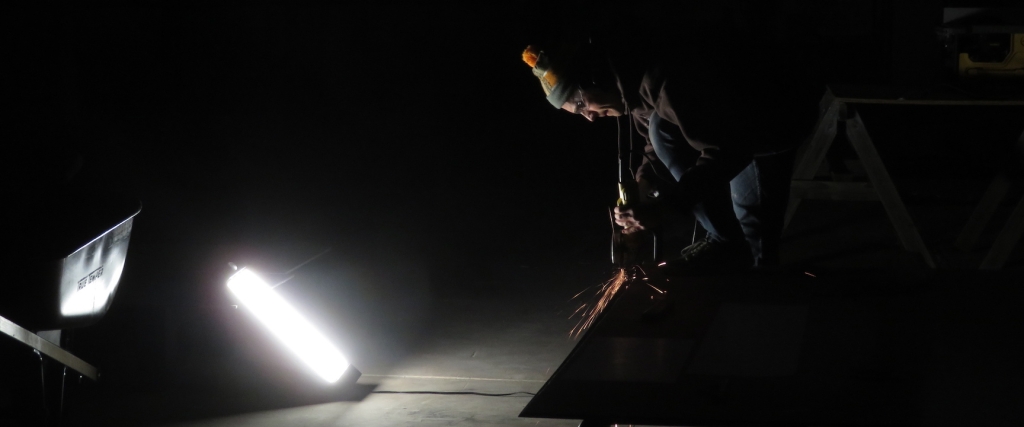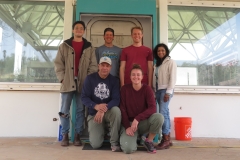
This past two weeks has seen a number of disparate tasks completed in parallel.
The two decades old shipping container serving as our Crew Quarters was designed to be air tight but not to hold pressure over time. This is compounded by skirmishes with forklifts that resulted in a few patches, bowed panels, and disconnected interfaces. As we have this past six months repaired the major leaks, smaller holes have been exposed. Our most recent pressure test discovered a leak at the overlapping seam between the stainless steel frame and aluminum ceiling roll at the back of the 40′ shipping container. Kai removed the failed rivet and drew open the enveloped just wide enough to inject 795 silicone. A new rivet drew the the interface tight again. Bindhu then scraped and cleaned the entire interface that spans the width of the container, followed by an application of aluminum tape with assistance from John Z. The entire perimeter of the wall-to-ceiling interface is now complete.
Kai and Sean worked to prepare for the installation of the electrical sockets in the workshop (20 foot container) with fabricated aluminum plates to give strength to the in-house designed, modular wall mount system. Subsequently, three 20 amp electrical circuits were installed. The original, exterior steel door to the Test Module was removed last fall, sanded, primed, and recently top-coated with Rust-Oleum white enamel paint, the same that now protects the entire exterior of the refurbished shipping containers and airlock. With new, steel bearing hinges, the door was replaced and is incredibly smooth in its operation, ready for three more decades of service.
Following several applications of PB Blaster over the prior week, Kai and John Z attempted (in vain) to remove an old “J” pipe fitting on the exterior of the B2 airlock installed at SAM last year. The 4 foot, 30 lbs wrench was apparently not large enough, and in the end the fitting was cut free, the remnant filled with foam, to be capped and sealed soon.
Arizona State University undergraduate student and new volunteer at SAM Tasha Coelho applied diligent attention to the final effort in restoration of the original Test Module lung. She scraped free all loose paint and then hand-sanded the underbelly of the pan in preparation for a coat of Rust-Oleum primer. Luna then applied two coats of a beautiful, dark blue-grey semi-gloss enamel.
Sean and our new volunteer Matthias Beach tackled the installation of the new variable frequency drive (VFD) blower to inflate the lung and pressurize SAM. Matthias is a Former Air Force Computer and Switching Systems Specialist and citizen telecommunications field service specialist who brings skills in construction, electrical wiring, and equipment operation to this endeavor at a critical time. The VFD motor is 1 HP (as compared to the former blower of 1/3 HP) with a significantly larger blower which will result in our ability to inflate SAM in far less time than the former 15 minutes, and with the variable speed control, maintain a constant, minimal influx of air for those teams preferring to run SAM in either of the two pass-through modes.
In the midst of our third snow storm this winter, Matthias, Sean, Tasha, and Luna completed the wiring of the Test Module that was begun last year, with eight 20 amp circuits ready to handle the most arduous of hydroponic racks.


